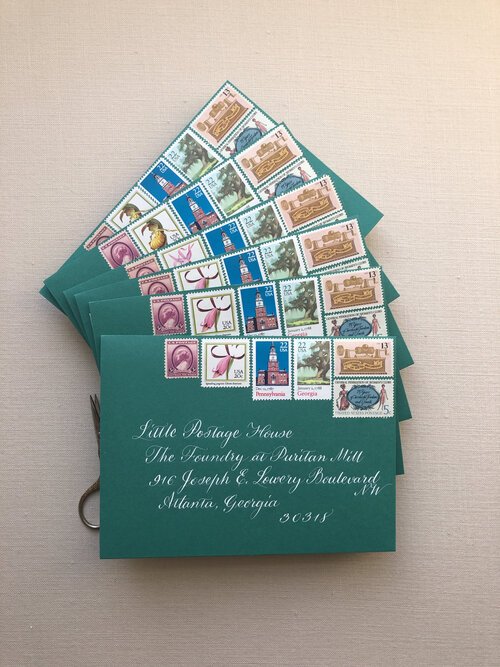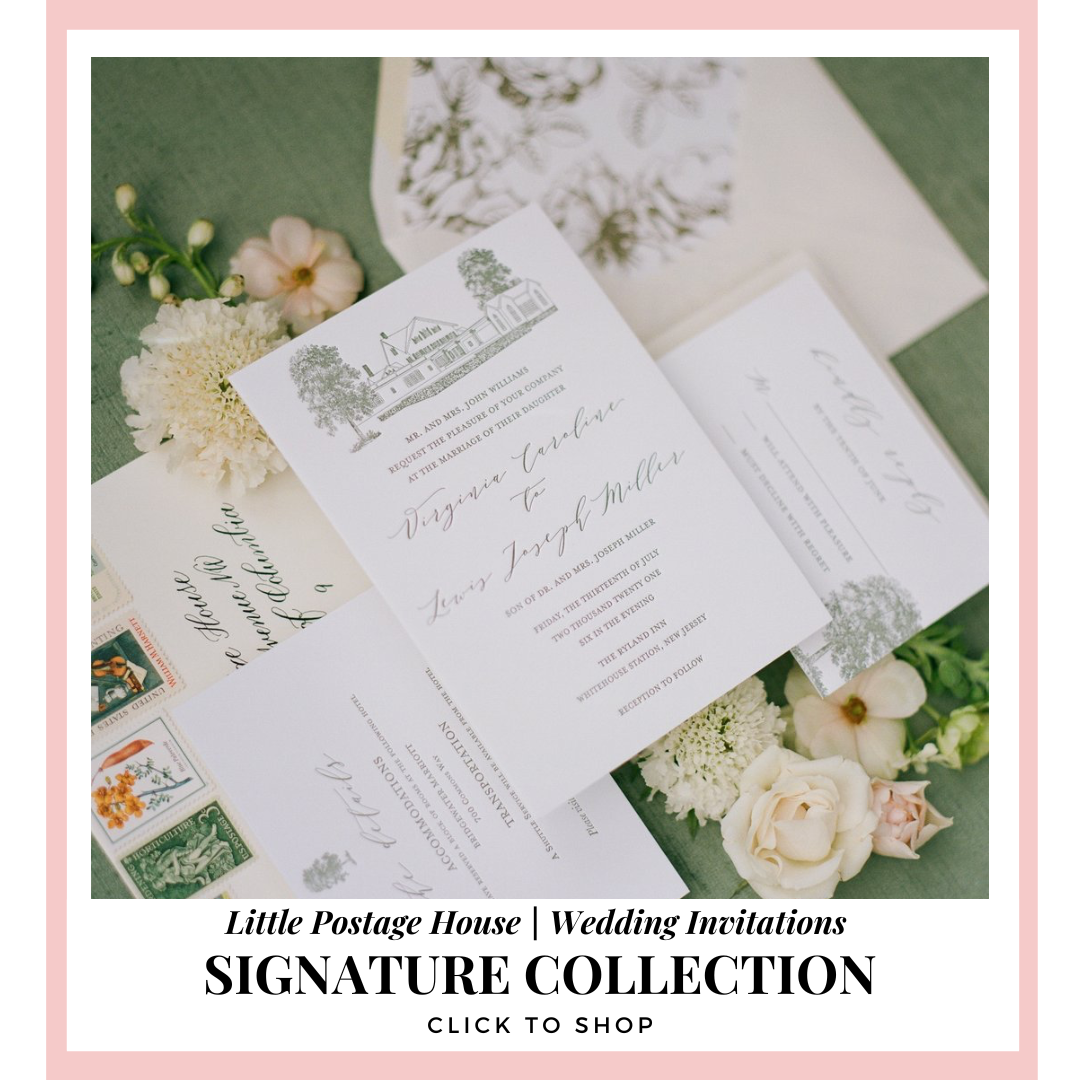How Much Postage Do I need?
Before planning a wedding, most of us know little to nothing about postage rates or the post office. I mean we know that postage stamps exist and that we need to stick them onto letters to mail them, but that’s about everything that we know. It isn’t until the wedding invitation process rolls around that we are forced to learn the mystical ways of the United States Postal Service.
If you’re interested in fun, unique postage, we have an extensive collection of vintage postage, and we even offer services to curate it for you and apply it to your mail!
On the surface, it can seem like an overwhelming system. Okay, so here are the basics:
Postage Categories
There are three postage categories that we generally deal with in the wedding industry:
standard letters,
large envelopes (aka, flats), and
parcels.
Each category comes with its own postage rates and rules. The good news is that the overwhelming majority of couples that we work with will be in the “standard letter” category, so it is very unlikely that you will need to worry about the other categories at all! The “large envelope” and “parcel” categories come up when wedding invitations are ultra thick (things like acrylic invitations or cards with bulky magnets on the back). For the most part, a traditional A7 wedding invitation (e.g., one that measures 5 x 7) is usually considered a standard letter by USPS, even if it has a wax seal or ribbon!
Standard Letters
In 2024, the postage rate for a standard letter starts at 73 cents of postage. USPS will charge extra postage on top of this based on the characteristics of the mailing. Specifically, USPS will look at the weight of the letter and the general characteristics of the invitation.
As mentioned above, a traditional A7 wedding invitation (5 x 7) is usually considered a standard letter by USPS. If the envelope is over either 6⅛″ in height, 11½″ in width, or ¼″ in thickness, it gets bumped into the large envelope category (which requires extra postage and different rules apply to large envelopes).
Weight
This is one is pretty simple and straightforward. A standard letter that weighs under one (1) ounce will require 73 cents of postage to mail in 2024. USPS charges extra postage for any weight above that amount. In 2024, USPS charges an extra 28 cents for each additional ounce. So a letter that weighs between one (1) and two (2) ounces will require $1.01 in postage. This is true even if the mailing weighs even a little over the weight class limitation (e.g., 1.01 ounces).
The Non-Machinable Surcharge
Aside from weight, USPS also looks at the characteristics of the letter to determine if it is “non-machinable”. This is a little tricky, because it is subjective in nature. Specifically, USPS checks to see if the letter is rigid, lumpy, has a wax seal (either in the inside or outside of the envelope), or are square-shaped. If USPS determines that any of these characteristics are true, it will charge a “non-machinable surcharge,” because they will take the position that the letter can’t be automatically processed through their sorting machines. The “non-machinable surcharge” is an additional 46 cents of postage.
Large Envelopes // Flats
If an invitation is over either 6⅛″ in height, 11½″ in width, or ¼″ in thickness, it gets bumped into the large envelope category (which requires extra postage and different rules apply to large envelopes).
The postage rate of large envelopes (also known as flat mail) starts at $1.50 in 2024 and goes up in 27 cents intervals based on weight. For example, a “flat” that weighs 1.05 ounces will require $1.77 cents to mail.
The same “non-machinable” rule described above (in the standard letter section) does not apply here. Instead, if the flat is rigid or contains items that cause more than 1/4 inch variation in thickness, USPS may bump the mailing into the “parcel” category.
Parcels
If the large envelope is rigid, contains items that cause more than 1/4 inch variation in thickness, or it is more than ¾″ thick, 12″ high, 15″ long or weighs more than 13 ounces, USPS may consider the envelope, a parcel.
Parcels require a ton of postage (e.g., $3 to $5 each in postage). The amount of postage actually varies by the destination, so you would need a list of all of the zip codes that the invitations are going to.
***
I hope that is guide is helpful! Please feel free to email us if you have any questions at all! We’re always happy to help and help you navigate the postal system! For brides interested in working with us on a curated vintage postage set or their wedding invitations, there is no need to worry about any of this! I will estimate the postage rate for you during the design process! See our vintage postage curation services!
To see our custom and semi-custom wedding invitation options, click below!
* Please note that all postage rates mentioned in this article are based on the USPS postage rates for 2024. However, USPS reviews the postage rates on a bi-annual basis and may change such rates. Please refer to the most recent article on our blog to learn more about current rate. Subscribe to our newsletter to stay up-to-date on postage rates.
** Please make sure to the confirm the required postage rate with USPS prior to mailing out your wedding invitations or other letters. This article is only intended to be a helpful resource guide. However, postage rates will vary and depend on the specific characteristics of your mailing. **





